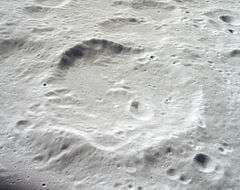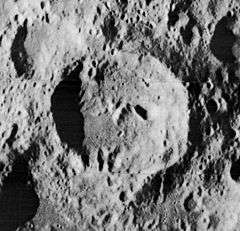Racah (crater)
Racah is a lunar impact crater on the far side of the moon. It lies almost due south of the larger crater Daedalus, and lies across lunar longitude 180°W, i.e. the longitude that is diametrically opposite to the Earth. To the west-southwest of Racah is the crater Aitken, and to the southeast lies De Vries.
 Oblique Apollo 17 image | |
| Coordinates | 13.8°S 179.8°W |
|---|---|
| Diameter | 63 km |
| Depth | Unknown |
| Colongitude | 180° at sunrise |
| Eponym | Giulio Racah |

The rim of this crater is eroded and is not quite circular, having a prominent outward bulge along the west-northwest side. The edge is somewhat damaged along the southern rim, but no significant craters lie along the side. The interior floor is uneven in places with some small impacts.
This feature is named after the Israeli physicist Giulio Racah.
Satellite craters
By convention these features are identified on lunar maps by placing the letter on the side of the crater midpoint that is closest to Racah.
| Racah | Latitude | Longitude | Diameter |
|---|---|---|---|
| B | 10.5° S | 178.4° W | 27 km |
| J | 16.5° S | 177.4° W | 37 km |
| K | 16.8° S | 178.6° W | 52 km |
| N | 17.0° S | 179.0° E | 35 km |
| T | 13.8° S | 177.5° E | 21 km |
| U | 13.2° S | 177.2° E | 25 km |
| W | 12.5° S | 178.9° E | 39 km |
| X | 10.2° S | 179.0° E | 14 km |
References
- Andersson, L. E.; Whitaker, E. A. (1982). NASA Catalogue of Lunar Nomenclature. NASA RP-1097.CS1 maint: ref=harv (link)
- Blue, Jennifer (July 25, 2007). "Gazetteer of Planetary Nomenclature". USGS. Retrieved 2007-08-05.CS1 maint: ref=harv (link)
- Bussey, B.; Spudis, P. (2004). The Clementine Atlas of the Moon. New York: Cambridge University Press. ISBN 978-0-521-81528-4.CS1 maint: ref=harv (link)
- Cocks, Elijah E.; Cocks, Josiah C. (1995). Who's Who on the Moon: A Biographical Dictionary of Lunar Nomenclature. Tudor Publishers. ISBN 978-0-936389-27-1.CS1 maint: ref=harv (link)
- McDowell, Jonathan (July 15, 2007). "Lunar Nomenclature". Jonathan's Space Report. Retrieved 2007-10-24.CS1 maint: ref=harv (link)
- Menzel, D. H.; Minnaert, M.; Levin, B.; Dollfus, A.; Bell, B. (1971). "Report on Lunar Nomenclature by the Working Group of Commission 17 of the IAU". Space Science Reviews. 12 (2): 136–186. Bibcode:1971SSRv...12..136M. doi:10.1007/BF00171763.CS1 maint: ref=harv (link)
- Moore, Patrick (2001). On the Moon. Sterling Publishing Co. ISBN 978-0-304-35469-6.CS1 maint: ref=harv (link)
- Price, Fred W. (1988). The Moon Observer's Handbook. Cambridge University Press. ISBN 978-0-521-33500-3.CS1 maint: ref=harv (link)
- Rükl, Antonín (1990). Atlas of the Moon. Kalmbach Books. ISBN 978-0-913135-17-4.CS1 maint: ref=harv (link)
- Webb, Rev. T. W. (1962). Celestial Objects for Common Telescopes (6th revised ed.). Dover. ISBN 978-0-486-20917-3.CS1 maint: ref=harv (link)
- Whitaker, Ewen A. (1999). Mapping and Naming the Moon. Cambridge University Press. ISBN 978-0-521-62248-6.CS1 maint: ref=harv (link)
- Wlasuk, Peter T. (2000). Observing the Moon. Springer. ISBN 978-1-85233-193-1.CS1 maint: ref=harv (link)